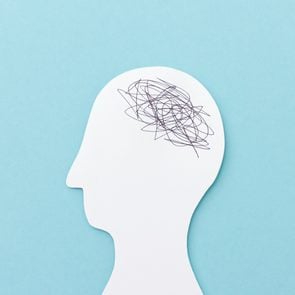What Is Catastrophizing?
Updated: Nov. 10, 2021
Does one bad date make you fear you'll be alone forever? You may be catastrophizing—a type of cognitive distortion that makes worst-case scenarios seem likelier than they are.
What is cognitive distortion?
Our brains are constantly building connections, forming relationships between our experiences, thoughts, actions, and consequences. It’s this ongoing process that shapes each person’s view of the world—and affects everything from our reactions to daily problem-solving.
But sometimes, our brains build cause-and-effect relationships based on overly simplistic, coincidental, or simply incorrect associations.
These biased thought patterns—known as cognitive distortions—usually aren’t grounded in reality and tend to skew negative, says Alissa Jerud, PhD, a licensed clinical psychologist and clinical assistant professor of psychology at the University of Pennsylvania.
One common way people distort their worldview is by catastrophizing. Here’s what experts want you to know about this cognitive distortion, including how to overcome this type of thinking.
What are the different kinds of cognitive distortion?
We all experience irrational thoughts now and again. Yet reinforcing negative thought patterns alters our sense of well-being for the worse.
Psychologist Aaron Beck first proposed this theory of cognitive distortion in 1976. His student David Burns, now a psychiatrist and adjunct clinical professor emeritus at Stanford University School of Medicine, continued Beck’s work by cataloging how our brains tend to manufacture faulty connections.
“None of them is one-size-fits-all,” explains Erica Cramer, a therapist at Cobb Psychotherapy in New York.
But according to Burns’ research, some common ways we cognitively distort our view of the world include:
- filtering, magnifying, and dwelling on negative details
- black-and-white or all-or-nothing thinking
- overgeneralization, like thinking that something “always” or “never” happens
- jumping to conclusions, mind reading, and predictive fortune-telling
- emotional reasoning, or coming to conclusions based on your feelings alone
- thinking in terms of “should,” “must,” or “ought to” statements
- holding yourself personally responsible (or blaming others) for things out of your control
- catastrophizing

What is catastrophizing?
“[Catastrophizing] is when you think the worst-case scenario is the most likely scenario,” Cramer says. “Rather than there being an equal chance of something going right or wrong, you assume you are destined to experience a negative outcome.”
This line of thinking generally starts with information that has a kernel of truth to it, says Gail Saltz, MD, a clinical associate professor of psychiatry at New York Presbyterian Hospital and host of the How Can I Help? podcast from iHeartRadio.
But when someone has a catastrophic thought pattern, their imagination takes an otherwise small concern and unravels it to the nth degree—the worst place it can go.
Dr. Saltz says to imagine a dark and gloomy day.
“You look outside, and you think: There’s a thundershower coming; my child’s on her way home from school. It’s probably going to suddenly hit, then she may get struck by lightning and killed, and I will never be able to survive myself because I’ll be in mourning,” she explains. “That would be catastrophizing.”
What causes catastrophic thinking?
“We all engage in catastrophic thinking at times, and there are likely evolutionary roots to this type of thinking,” Dr. Jerud says.
“In fact, catastrophizing may have even been adaptive for our ancestors, as it may have led them to be more vigilant and thus better able to evade potential predators.”
But Dr. Saltz says switching these evolutionary alarm bells to overdrive can turn catastrophic thinking into an automatic response. Someone living with this cognitive distortion may habitually scan their environment and over-interpret signs of potential danger, concluding the worst-case scenario is the only possible outcome.
This snowball effect takes us beyond day-to-day worries. Dr. Jerud explains catastrophizing is believing that not only will you stutter during your upcoming job interview, but you won’t get that job or any other job. Therefore, you’ll be unemployed forever.
“There are infinite causes for cognitive distortions,” Cramer says. “Different situations affect people in different ways.”
That’s why there’s no one trigger for catastrophic thinking. People can develop an ingrained catastrophic thought cycle in response to a wide range of situations, like:
- past trauma
- bad parenting
- work or relationship stress
- low self-esteem or imposter syndrome
- conditions like depression or anxiety
Is catastrophizing the same as anxiety?
Catastrophic thinking (and other cognitive distortions) is especially common among individuals who struggle with anxiety, Dr. Jerud says. But they’re not mutually exclusive: Not everyone with anxiety gets caught in catastrophic thought patterns.
Still, research published in Cognitive Therapy and Research found that catastrophizing is a predictor for mental health conditions, including anxiety, panic, post-traumatic stress, and obsessive-compulsive disorders.
Catastrophic thinking can also fuel an existing anxiety disorder.
“The more you have these catastrophic thoughts, the higher your anxiety does tend to stay,” Dr. Saltz says. “It’s kind of a vicious loop.”
Is catastrophizing connected to other health conditions?
People can engage in catastrophizing without any underlying medical cause. However, research suggests a few conditions may influence catastrophic thought cycles (in addition to anxiety disorders.)
Chronic pain
Experiencing chronic or long-term pain is a common avenue to catastrophizing thoughts. Research published in Expert Review of Neurotherapeutics discusses how people with chronic pain often:
- worry that they’ll always be in pain (or that it will get continually worse)
- magnify the threat value of their pain
- feel helpless that there’s nothing they can do to reduce their pain
- exaggerate anticipated painful situations
Practical Pain Management reports that these catastrophic thoughts can actually increase someone’s physical pain—while putting them at a higher risk for disability and complementary conditions like depression.
Another 2020 study in the journal PAIN found that pain catastrophizing also leads people to avoid exercise or movement altogether, increasing their potential for greater pain, depression, and poor health outcomes.
Depression
While having catastrophic thoughts is more commonly associated with anxiety, these patterns have a link to depressive disorders, too.
Cramer explains that people with depression are more likely to feel like nothing goes right in their lives or that everyone has a low opinion of them. This pattern of negative thinking can make someone more susceptible to developing cognitive distortions like catastrophizing.
Fatigue
Catastrophizing can cause somatic—aka physical—symptoms as well. Cramer says cognitive distortion thought patterns could cause someone so much anxiety they experience back pain or headaches, for example.
“[Catastrophizing] can also make you tired because you are overthinking everything,” she adds.
Research backs up this association. A literature review published in the Journal of Psychosomatic Research suggests someone’s tendency to catastrophize is a good predictor of their fatigue levels and how much that fatigue disrupts their life.
How to overcome catastrophic thinking
Worries, anxieties, and negative thoughts are a normal part of life. But when they evolve into habitual cognitive distortions, these thought patterns can affect your physical and mental health alike.
“When we engage in catastrophic thinking, we often miss out on what’s happening in the present moment, which can make it hard to enjoy day-to-day life,” Dr. Jerud says.
She recommends acknowledging that a feared outcome could happen (as opposed to “will” happen) and then gently shifting your attention back to the present moment. Just don’t try to push the thoughts away, disprove them, or convince yourself that your feared outcomes won’t happen.
“The goal here isn’t to get rid of the catastrophic thoughts, but simply to not allow them to dictate what you do or don’t do,” she explains.
“This is key because efforts to avoid catastrophic thinking often backfire, causing these thoughts to pop up even more intensely.”
Still, rewiring our negative thought patterns might be easier said than done. That’s why the experts recommend a few approaches to help you overcome catastrophic thinking.

Therapy
Cognitive-behavioral therapy (CBT) is a psychological treatment that aims to change thought patterns. According to the American Psychological Association, CBT can help patients:
- learn to recognize and reevaluate their cognitive distortions
- develop problem-solving skills and coping mechanisms that help reduce the effect of cognitive distortion triggers
- build a greater sense of self-confidence, limiting the control that negative fears have over them
“It analyzes how your thoughts influence your feelings and behaviors,” Cramer explains.
She says CBT not only equips people with concrete tools to recognize and combat their distortions, but when practiced regularly enough, these learned skills become habits, replacing formerly catastrophic thought patterns.
Medication
While catastrophizing isn’t a medical diagnosis itself, it’s often a symptom of conditions like generalized anxiety disorder.
Dr. Saltz says that for people with high anxiety levels, medication can help reduce symptoms, including diminishing their catastrophic thinking.
Mindfulness
Cramer says building a practice around distinguishing facts from feelings—a form of mindfulness—can help stop catastrophic thinking in its tracks.
“Whenever you are thinking a negative thought, determine if it is a feeling or fact,” she says.
“If you do not have any evidence to support the thought, it is simply a feeling and not the actual truth. Anyone can believe anything they want, but is it actually true?”
Exercise
Physical activity reduces the impact of anxiety disorders on people’s lives, including generalized anxiety disorder, panic disorder, post-traumatic stress disorder, obsessive-compulsive disorder, and social anxiety disorder.
That’s because, according to Harvard Medical School, exercise:
- reduces levels of the body’s stress hormones
- stimulates the production of endorphins—the body’s natural painkillers and mood elevators
- improves self-image
- increases strength, stamina, and energy levels
- helps people build routines and social connections
Research published in Frontiers in Psychiatry found that regular exercise may even have a protective effect against the development or progression of mental health conditions. Similar to the medication approach, focusing on ways to treat someone’s underlying anxiety may help reduce their catastrophic thinking.
Get another perspective
“Sometimes it is helpful to share your feelings with others and get an outside perspective,” Cramer says.
“Asking questions like ‘Do you think this will likely happen?’ or ‘How do you view this situation?’ can definitely help you stay grounded and question your negative thoughts.”



